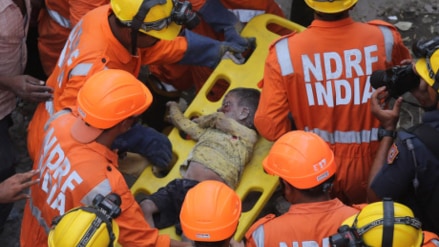Recent cloudbursts aggravated landslides and flash floods in parts of Uttarakhand, Himachal Pradesh, Jammu, and Punjab exposed India’s climate vulnerability. With the Himalayan mountains in the north, desert in the west and a long peninsula jutting into the seas, India remains in a unique position, as it is threatened by natural disasters of every kind. Over the past few decades, India has not only strengthened its disaster management systems but also emerged as a key responder and donor in the region.
At the heart of these efforts stands the National Disaster Response Force (NDRF). Yet, as extreme weather events intensify — claiming hundreds of lives across states like Uttarakhand and Punjab this monsoon — the force continues to grapple with daunting challenges on the ground. To understand the realities of disaster response, Financialexpress.com spoke to Inspector General Narendra Singh Bundela, the NDRF second-in-command, on the evolving role of technology, the mental toll on first responders and the urgent need to expand India’s disaster preparedness ecosystem.
NDRF launched numerous joint operations in the past weeks alongside SDRF and the national armed forces in a coordinated attempt to save lives. Despite NDRF’s impressive efforts, the recent wave of disasters from June to September claimed the lives of roughly 537 individuals in India, with many still reported as ‘missing’.
‘Radar detectors don’t work,’ IG Narendra Bundela
Among many challenges exposed by the IG, one that they are trying to actively work upon is the procedure of finding and retrieving human bodies in the aftermath of a disaster. “In certain cases of either a heavy building collapse or a landslide, retrieving humans and especially dead bodies becomes a big challenge, as a lot of equipment doesn’t work under these conditions. The available radar detectors can only identify metals or a buried house, but not dead bodies. Conversely, canines can be very effective in detecting human remains as they can smell things. So we are training our canines for such operations now, and we believe they will be a big asset for us,” Bundela said.
When asked about whether NDRF would look to update its equipment to incorporate modern-day technological capacities like China and Japan, where these countries use AI drones and small remote vehicles to reduce risk during missions, Bundela responded that NDRF is exploring those options but does not have a big update yet.
He further added that the Indian units are self-sustained to handle ground-based disasters like earthquakes and building collapse; however, there remains a major room for improvement in the early warning systems for cloudbursts and landslides.
Mental health support
Bundela also shed light on some of the psychological battles faced by first responders whilst carrying out these operations. “You may be handling multiple rotten, dead bodies at a point because we take a lot of time to extricate them from the landslide area. So, yes, that’s particularly tough for the rescuers when they are working day and night to retrieve those dead bodies. They see a lot of trauma cases also when saving the victim,” he explained.
The IG then talked about recent systems that had been put in place to provide these soldiers some mental health support and counselling as per their requirements. “We have a mechanism in place when they are back from the operation. So we get feedback from them, and we give them the option also. So there will be counsellors, identified counsellors in the battalion or wherever they are located. This is a very important system for us, and we try to ensure that it is followed properly,” he added.
Plans for expansion
When asked about how the force is preparing itself to brace for one of the wettest Septembers yet, which will prompt disasters as we’re now witnessing in Dehradun, Bundela responded that the state and national forces are in conversation to expand the capacity of state disaster forces and create a more holistic ecosystem.
